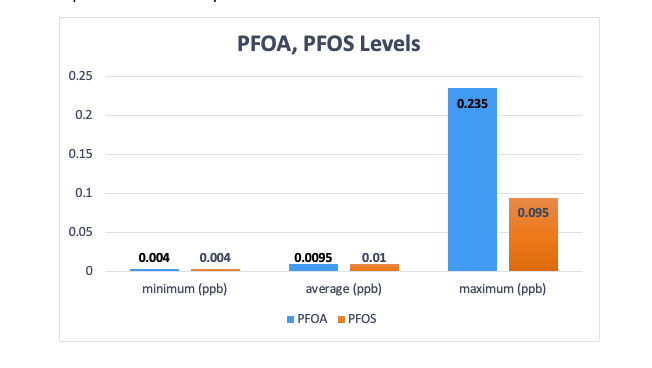The Guardian's August 17 headline, “Drinking Water of Millions of Americans Contaminated with Forever Chemicals”, was based on newly released data from EPA’s Fifth Unregulated Contaminant Monitoring Rule. Contrary to the headlines blasted in the media, the actual data from this rule shows that Americans have nothing to fear from these chemicals.
Background
The initial data just released from EPA’s Fifth Unregulated Contaminant Monitoring Rule (UCMR-5), a credible data source with a 20-year history, includes data on 29 PFAS, the “forever chemicals.” UCMR-5 requires the collection of water samples in all public drinking water supplies serving more than 3,300 people and a representative sample of those serving fewer than 3,300 people (but does not include private wells) every five years, measuring a different set of unregulated contaminants each time. The initial data from the samples to be collected between 2023 and 2025 were just released, representing approximately 7% of the total results the EPA expects to receive over the next three years.
Although these results represent only a small percentage of the total that will be available in the next few years, they take on increased significance because they will be a primary element of EPA’s support for its proposed drinking water regulation for PFAS, submitted in March 2023. All of the data from the UCMR-5 showing that PFAS occurs in drinking water systems will be used by EPA to support and finalize their regulatory agenda.
Although the percentage of water systems containing PFAS is important, it is secondary to the threshold issue: the EPA’s health advisory, their benchmark for PFAS, is not supported by science and was driven by EPA’s desire to set as low a number as possible. This is what is driving most of the fear around PFOS.
The EPA is attempting to demonstrate a health risk by comparing the levels of PFAS found in UCMR-5 with their health advisories – non-regulatory guidance on the concentrations of contaminants in drinking water at which adverse health effects are not expected to occur. If the contaminant levels found in UCMR-5 exceeded the health advisories, EPA concluded a potential health risk was present.
The EPA’s health advisory of 0.000004 parts per billion (ppb), for PFOA, and 0.00002 ppb, for PFOS are based on non-credible science and are much lower than those calculated by other agencies and countries. Because these health advisory levels are set so low, any amount of PFOA/PFOS found in drinking water is considered by EPA to be a health risk.
The Results from UCMR-5
Key fundamentals:
- Approximately 2,000 public water systems reported results in this initial data group, providing 4,700 total water samples (more than one sample was taken per water system).
- Monitoring was conducted for 29 PFAS, including PFOA, PFOS, and lithium.
- The minimum reporting level (MRL), the lowest concentration considered achievable by at least 75% of laboratories nationwide, was 0.004 ppb for PFOA and PFOS.
- Since the MRL of 0.004 ppb for PFOA and PFOS exceeds the health advisories’ of 0.000004 ppb for PFOA and 0.00002 ppb for PFOS, all results reported were considered a health risk.
PFOA Results
- 267 results out of 4,667 total results (5.7%) exceeded the MRL of 0.004 ppb.
- 156 public water systems out of 2,002 public water systems (7.8%) had at least one result above the MRL.
- The average level was 0.0095 ppb, the maximum was 0.235 ppb, and the minimum was 0.004 ppb.
- 68% (183) of the systems that exceeded the MRL used groundwater as a source; larger systems were represented more than small ones. [1]
PFOS Results
- 279 results out of 4,665 total results (6.0%) exceeded the MRL of 0.004 ppb.
- 170 public water systems out of 2,001 public water systems (8.5%) had at least one result above the MRL.
- The average level was 0.01 ppb, the maximum was 0.095 ppb, and the minimum was 0.004 ppb.
 Like PFOA, most (200) of the systems with MRL exceedances used groundwater as a source and were larger rather than smaller systems.
Like PFOA, most (200) of the systems with MRL exceedances used groundwater as a source and were larger rather than smaller systems.
The average levels of PFOA and PFOS were almost identical; however, a higher maximum level was reported for PFOA compared to PFOS.
There are only two other PFAS in UMCR-5 for which EPA has set Health Advisories, HFPO-DA (Gen-X) and PFBS. HFPO-DA was only measured above its Health Advisory in one out of 2,002 public water systems, and PFBS was not found above its Health Advisory in any water system. [2]
There are 25 other PFAS that have no Health Advisories. Nine were detected above their respective MRLs, and none of the other sixteen were found above them.
The Importance of an Appropriate Health Advisory
As previously discussed, the significance of the levels totally depends on the health advisories. Since EPA’s health advisories are so low, all levels appear to present a potential health risk.
But the picture changes when we compare the results with credible data, as developed by the Alliance for Risk Assessment. [3] Twenty-four scientists from eight countries were selected, divided into three independent teams, and reviewed relevant information and independently developed ranges for estimated PFOA-safe doses.
They developed a safe dose range of 10 to 70 nanogram (ng) per kilogram (kg)-body weight per day for PFOA. Their safe dose for PFOS has not been finalized.
This group of scientists developed a safe dose range, instead of a single number, to emphasize that the safe dose is not a bright line separating safe from unsafe chemical levels. Instead, it is an imprecise measure of the dose, if consumed over a lifetime, that may begin to present health effects in vulnerable individuals.
The safe dose is calculated to represent the safe dose of the chemical from all sources: food, water, and air. This dose is converted to a safe amount in drinking water only. EPA’s traditional conversion method [4] results in a range of 0.07 – 0.5 ppb or an average safe level of 0.3 ppb for an adult. This level is above the average and maximum levels of PFOA, and PFOS detected in UCMR-5, indicating no health risk.
The EPA’s entire PFAS campaign is founded on the faulty foundation of its health advisories. As I’ve previously written, the health advisories for PFOA and PFOS are based on a study in the Faroe Islands and demonstrates why health advisories should be part of an open, public comment process. The extraordinarily low numbers will lead to years of litigation, unnecessary consumer fear, and billions of dollars spent on low-risk compounds. The billions that EPA plans to spend would be much better spent on true risks to public health from drinking water, such as aging infrastructure, small systems, and microbiological contaminants, such as Legionella, in plumbing.
[1] Groundwater = underground water in aquifers; surface water = water from lakes, streams, and rivers. EPA also characterized public water systems as using groundwater under the direct influence of surface water or mixed sources (groundwater and surface water).
[2] In these cases, EPA set Health Advisories based on science at reasonable levels: 0.01 ppb for HFPO-DA and 2 ppb for PFBS, translating into no risk from these compounds.
[3] A global cooperative involving government, industry, academic, and environmental stakeholders.
[4] A 70 kg adult consuming 2 liters of water per day, allocating 20% of the total safe dose to drinking water.

